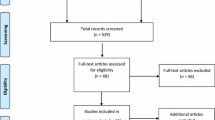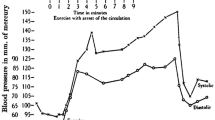Abstract
This study was performed to compare skinned fibers from rabbit adductor magnus (AM) and soleus (SL) muscles with regard to the influence of caffeine, Ca2+ and Mg2+ on the depressive effects of ryanodine (RYA) on the caffeine-induced tension transients. Single skinned fibers were immersed in solution: to load Ca2+ into, and release Ca2+ from the SR (a load-release cycle). Three cycles were sequentially performed in each skinned fiber: (1) a control (no RYA) (2) a conditioning period in which activation was car ried out in the presence of ryanodine plus various con centrations of the modulators, i.e. caffeine, Ca2+ or Mg2+, and (3) a test (no RYA) which monitored the release activity retained after the conditioning cycle. The depressive effect of RYA was found to be a function of [ryanodine], [caffeine], or [Ca2+], and an inverse function of [Mg2+], where [caffeine] denotes concentration. The half-maximal effects of RYA in AM (5 μM RYA) and SL (10 μM RYA), respectively, occurred at a pCa50 of 5.32 versus 5.43 without caffeine, or pCa50 of 7.24 versus 6.88 and pMg50 of 3.29 versus 3.61 with 25 mM caffeine, at a [caffeine] of 4.96 versus 7.29 mM, and at a [ryanodine] of 31.0 versus 101.6 μM. Thus, the RYA depression in skinned muscle fibers is modulated by caffeine, Ca2+, and Mg2+ in both muscle types, and AM is at least two- to fourfold more sensitive than SL.
Similar content being viewed by others
References
Atlman DG (1991) Practical statistics for medical research. Chapman and Hall, New York, pp 179–205, 325–335
Bull R, Marengo JJ (1993) Sarcoplasmic reticulum release channels from frog skeletal muscle display two types of calcium dependence. FEBS Lett 331:223–227
Damiani E, Margreth A (1994) Characterization study of the ryanodine receptor and of calsequestrin isoforms of mammalian skeletal muscles in relation to fibre types. J Muscle Res Cell Motil 15:86–101
Endo M (1975) Mechanism of action of caffeine on the sarcoplasmic reticulum of skeletal muscle. Proc Jpn Acad 51:479–484
Fabiato A, Fabiato F (1975) Contractions induced by a calcium triggered release of calcium from the sarcoplasmic reticulum of single skinned cardiac cells. J Physiol (Lond) 249:469–495
Guardabasso V, Munson PJ, Rodbard D (1988) A versatile method for simultaneous analysis of families of curves. FASEB J 2:209–215
Lee YS, Ondrias K, Duhl AJ, Ehrlich BE, Kim DH (1991) Comparison of calcium release from sarcoplasmic reticulum of slow and fast twitch muscles. J Membr Biol 122:155–163
McPherson P, Campbell KP (1993) The ryanodine receptor/Ca2+ release channel. J Biol Chem 268:13765–13768
Meissner G, Darling E, Eveleth J (1986) Kinetics of rapid Ca2+ release by sarcoplasmic reticulum. Effects of Ca2+, Mg2+, and adenine nucleotides. Biochemistry 25:236–244
Ohlendieck K, Briggs FN, Lee KF, Wechsler AW, Campbell KP (1991) Analysis of excitation-contraction-coupling components in chronically stimulated canine skeletal muscle. Eur J Biochem 202:739–747
Pessah IN, Stambuk RA, Casida JE (1987) Ca2+-activated ryanodine binding: mechanisms of sensitivity and intensity modulation by Mg2+, caffeine, and adenine nucleotides. Mol Pharmacol 31:232–238
Procita L (1956) The action of ryanodine on mammalian skeletal muscle in situ. J Pharmacol Exp Ther 117:363–373
Rios E, Pizarro G (1991) Voltage sensor of excitation-contraction coupling in skeletal muscle. Physiol Rev 71:849–908
Rousseau E, Meissner G (1987) Ryanodine modifies conductance and gating behavior of single Ca2+ release channel. Am J Physiol 253:C364-C368
Salviati G, Volpe P (1988) Ca2+ release from sarcoplasmic reticulum of skinned fast- and slow-twitch muscle fibers. Am J Physiol 254:C459-C465
Smith JS, Coronado R, Meissner G (1986) Single channel measurements of the calcium release channel from skeletal muscle sarcoplasmic reticulum. Activation by Ca2+ and ATP and modulation by Mg2+. J Gen Physiol 88:573–588
Su JY (1987) Effects of ryanodine on skinned skeletal muscle fibers of the rabbit. Pflügers Arch 410:510–516
Su JY (1988) Effects of ryanodine on skinned myocardial fibers of the rabbit. Pflügers Arch 411:132–136
Su JY (1988) Mechanisms of ryanodine-induced depression of caffeine-induced tension transients in skinned striated rabbit muscle fibers. Pflügers Arch 411:371–377
Su JY (1992) Influence of caffeine, Ca2+, and Mg2+ on ryanodine depression of the tension transient in skinned myocardial fibers of the rabbit. Pflügers Arch 421:1–6
Su JY, Chang YI (1993) Modulation of sarcoplasmic reticulum Ca2+-release channels by caffeine, Ca2+, and Mg2+ in skinned myocardial fibers of fetal and adult rats. Pflügers Arch 421:300–306
Su JY, Hasselbach W (1984) Caffeine-induced calcium release from isolated sarcoplasmic reticulatum of rabbit skeletal muscle. Pflügers Arch 400:14–21
Su JY, Kerrick WGL (1979) Effects of halothane on caffeine-induced tension transients in functionally skinned myocardial fibers. Pflügers Arch 380:29–34
Zimanyi I, Pessah IN (1991) Comparison of [3H] ryanodine receptors and Ca2+ release from rat cardiac and rabbit skeletal muscle sarcoplasmic reticulum. J Pharmacol Exp Ther 256:938–946
Author information
Authors and Affiliations
Rights and permissions
About this article
Cite this article
Su, J.Y., Chang, Y.I. Modulation of the ryanodine receptor sarcoplasmic reticular Ca2+ channel in skinned fibers of fast- and slow-twitch skeletal muscles from rabbits. Pflügers Arch 430, 358–364 (1995). https://doi.org/10.1007/BF00373910
Received:
Revised:
Accepted:
Issue Date:
DOI: https://doi.org/10.1007/BF00373910




